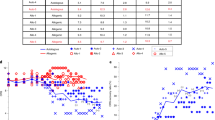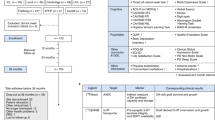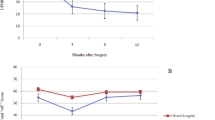Abstract
Substitutive therapy using fetal striatal grafts in animal models of Huntington disease (HD) have already demonstrated obvious beneficial effects on motor indices1. Using a new phenotypic model of HD recently designed in primates2,3, we demonstrate here complete and persistent recovery in a frontal-type cognitive task two to five months after intrastriatal allografting. The striatal allografts also reduce the occurence of dystonia, a major abnormal movement associated with HD. These results show the capacity of fetal neurons to provide a renewed substrate for both cognitive and motor systems in the lesioned adult brain. They also support the use of neural transplantation as a potential therapy for HD.
This is a preview of subscription content, access via your institution
Access options
Subscribe to this journal
Receive 12 print issues and online access
$209.00 per year
only $17.42 per issue
Buy this article
- Purchase on Springer Link
- Instant access to full article PDF
Prices may be subject to local taxes which are calculated during checkout
Similar content being viewed by others
References
Peschanski, M., Cesaro, P. & Hantraye, P. Rationale for intrastriatal grafting of striatal neuroblasts in patients with Huntington's disease. Neurosci. 68, 273–285 (1995).
Brouillet, E. et al. Chronic mitochondrial energy impairment produces selective striatal degeneration and abnormal choreiform movements in primates. Proc. Natl. Acad. Sci. USA 92, 7105–7109 (1995).
Palfi, S. et al. Chronic 3-nitropropionic acid treatment in baboons replicates the cognitive and motor deficits of Huntington's disease. J. Neurosci. 16, 3019–3025 (1996).
Harper, P.S. in Huntington's Disease Vol 1 (ed. Harper P.S.) (W. B. Saunders, London, 1991).
Brandt, J., Foldstein, S.E. & Folstein, M.F. Differential cognitive impairment in Alzheimer's disease and Huntington's disease. Ann. Neurol. 23, 555–561 (1988)
Butters, N., Sax, D., Montgomery, K., Tarlow, S. Comparison of the neuropsychological deficits associated with early and advanced Huntington's disease. Arch. Neurol. 35, 585–589 (1978).
Diamond, A., Zola-Morgan, S. & Squire, L.R. Successful performance by monkeys with lesions of the hippocampal formation on AB- and object retrieval, two tasks that mark developmental changes in human infants. Behav. Neurosci. 103, 526–537 (1989).
Jentsch, J.D. et al. Enduring cognitive deficits and cortical dopamine dysfunction in Monkeys after long-term administration of phencyclidine. Science 277, 953–955 (1997).
Schneider, J.S. in The Vulnerable Brain and Environmental Risks (eds. Isaacson, R.L. & Jensen, K.F.) 293–308 (Plenum, London, 1992).
Burns, L.H. et al. Selective putaminal excitotoxic lesions in non-human primates model the movement disorder of Huntington disease. Neurosci. 64, 1007–1017 (1995).
Hantraye, P., Riche, D., Maziere, M. & Isacson, O. An experimental primate model of Huntington's disease: anatomical and behavioural studies of unilateral excitotoxic lesions of the caudate-putamen in the baboon. Exp. Neurol. 108: 91–104 (1990).
Dunnett, S.B. in Functional Neural Transplantation (eds. Dunnett, S. B. & Björklund, A.) 217–251 (Raven, New York, 1994).
Sinden, J.D., Cray, J.A. & Hodges, H. in Functional Neural Transplantation (eds. Dunnett, S. B. & Björklund, A.) 253–294 (Raven, New York, 1994).
Chen, K.S. & Gage, F.H. in Functional Neural Transplantation (eds. Dunnett, S. B. & Björklund, A.) 295–316 (Raven, New York, 1994).
Isacson, O., Dunnett, S.B. & Björklund, A. Graft-induced behavioral recovery in an animal model of Huntington disease. Proc. Natl. Acad. Sci. USA 83, 2728–2732 (1986).
Mayer, E., Brown, V.J., Dunnett, S.B. & Robbins, T.W. Striatal graft-associated recovery of a lesion-induced performance deficit in the rat requires learning to use the transplant. Eur. J. Neurosci. 4, 119–126 (1992).
Hantraye, P.;, Riche, D.;, Maziere, M.;, Isacson, O. Intrastriatal transplantation of cross-species fetal striatal cells reduces abnormal movements in a primate model of Huntington disease. Proc. Natl. Acad. Sci. USA 89, 4187–4191 (1992).
Szabo & J. Cowan, W. M. Stereotaxis atlas of the brain of cynomolgus monkey (Macaca fascicularis). J. Comp. Neurol. 222: 265–300 (1984).
Naimi, S. Jeny, R. Hantraye, P. Peschanski, M. & Riche, D. Ontogeny of human striatal DARPP-32 neurons in fetuses and following xenografting to the adult rat brain. Exp. Neurol. 137, 15–25 (1996).
Pakzaban, P., Deacon, T.W., Burns, L.H. & Isacson, O. Increased proportion of acetylcholinesterase-rich zones and improved morphological integration in host striatum of fetal derived from the lateral but not the medial ganglionic eminence. Exp. Brain Res. 97, 13–22 (1993).
Brundin, P., Isacson, O. & Björklund, A. Monitoring of cell viability in suspensions of embryonic CNS tissue and its use as a criterion for intracerebral graft survival. Brain Res. 331, 251–259 (1985).
Hemmings Jr, H.C., Nairn, A.C., Aswad, D.W. & Creengard, P. DARPP-32, a dopamine- and adenosine 3′:5′-monophosphate-regulated phosphoprotein enriched in dopamine-innervated brain regions. J. Neurosci. 4: 99–110 (1984).
M.Hsu, S.Raine, L. & Fanger, H. Use of avidin-biotin-peroxydase complex (ABC) in immunoperoxidase techniques: A comparison between ABC and unlabeled antibody (PAP) procedures. J. Histochem. Cytochem. 29: 557–580 (1981).
Sternberger, L.A. in Immunocytochemistry 2nd edn. (John Wiley & Sons, New York, 1985).
Author information
Authors and Affiliations
Rights and permissions
About this article
Cite this article
Palfi, S., Condé, F., Riche, D. et al. Fetal striatal allografts reverse cognitive deficits in a primate model of Huntington disease. Nat Med 4, 963–966 (1998). https://doi.org/10.1038/nm0898-963
Received:
Accepted:
Issue Date:
DOI: https://doi.org/10.1038/nm0898-963
This article is cited by
-
Donor-containing cortical and intraventricular glioneuronal nodules in Huntington’s disease brain decades after fetal cell transplantation
Acta Neuropathologica (2021)
-
Nonhuman Primate Models of Stroke for Translational Neuroprotection Research
Neurotherapeutics (2012)
-
Human Pluripotent Stem Cell Therapy for Huntington’s Disease: Technical, Immunological, and Safety Challenges
Neurotherapeutics (2011)
-
Cellular Therapy and Induced Neuronal Replacement for Huntington's Disease
Neurotherapeutics (2011)
-
Expression of Mutated Huntingtin Fragment in the Putamen Is Sufficient to Produce Abnormal Movement in Non-human Primates
Molecular Therapy (2007)



